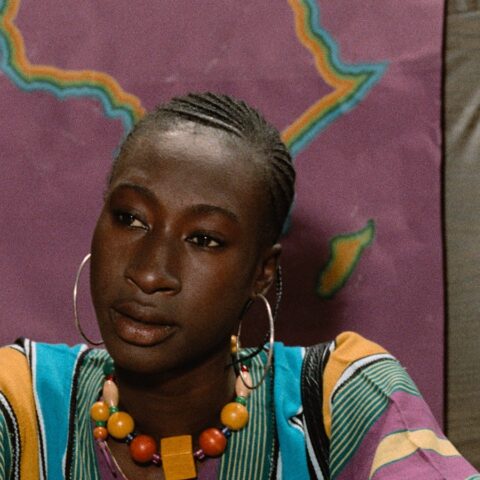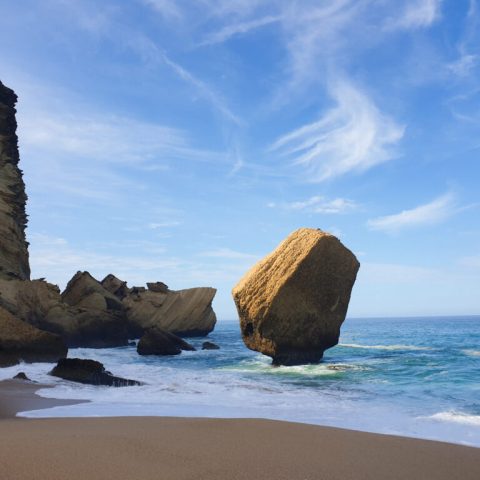REVIEW: CHRIS OFILI AT TATE BRITAIN
�
By Shaun Ajamu Hutchinson
�
Friday, April 09, 2010.
�
�
The red, black and green Union Black, currently fluttering from the flagpole of The Tate Britain in London, is the work of Chris Ofili, one of the most celebrated and popular artists of his generation. British born of Nigerian descent, Ofili’s works have been on display internationally, and the man himself won the prestigious Turner Prize in 1998, and he also represented Great Britain at the 50th Venice Biennale in 2003.
�
The sight of the flag in the liberation colours – created during the artist’s pan-African phase – provokes troubling questions; subversion, controversy and political theatricality, wrapped up in an Afrocentric mindset. All descriptions that perfectly sum up Ofili’s brilliant career to date. This time around, successive phases of the 41-year-old’s extensive creations are on show across several rooms. The works draw on eclectic political, musical and cultural influences, as well as those of his artistic contemporaries and forebears. In the process, Ofili gives us vibrantly coloured and intricately decorated paintings, compete with sculpture, pencil drawings and watercolours.
�
For over a decade, elephant dung, glitter and bright map pins, arranged as the names of his pieces, were Ofili trademarks. But this versatile collection is much more than elephant shit (which, in any case, give a three dimensional quality to the pieces, add a sculptural feel and function as pedestals); recent works are darker, conceptual and spiritually charged. And judging by the attendance at this show on a Spring Saturday, which is accompanied by good music, poetry and other events, you can argue that the award-winning artist has made art popular and funky.
�
The first phase [Early to Mid 1990s, Mid – Late 1990s] references two important factors: The artist’s 1990s scholarship in Zimbabwe and his own coming of age in the period of hip hop’s emergence. Here, we have corollary visual and aural impact, as a global art form.�
�
These visually stimulating pieces straddle the hip hop culture of that period – multi layered, cutting and mixing of styles, genres and materials – using diverse, sometimes discordant, methods and technique. Describing these pieces is like giving shout-outs to the pioneers of the genre; the eclectic Afrika Bambaata, Run DMC, Grandmaster Flash and The Furious Five; the funky Afrocentric and political – The Native Tongues; the freestyler like KRS One; the politically charged, such as Public Enemy, Tupac Shakur, Biggie, and the NWA; and the cultured and intelligent like Black Star.
�
The definite highlights of Ofili’s current exhibition include early hits Painting With Shit on It [1993]; and Spaceshit [1995]; the affecting and mournful No Woman, No Cry [1998] created in the aftermath of the inquiry into the racist murder of Stephen Lawrence; Blossom [1997] and sharp and textured The Adoration of Captain Shit and the Legend of the Black Stars [1998]. recalling the powerful imagery and graffiti style of Black Panther Party Minister for Culture Emory Douglas’ evocative and politically charged agit-prop. Then there are the graphic and extreme Holy Virgin Mary [1996]; radiant and mesmerising 1996’s Afrodizzia (Second Version).
�
Searching for and discovering the sometimes cryptic, sometimes overt clues here, is like a music aficionado identifying the breaks used in a hip-hop backing track.
�
These controversial pieces have the air of the blatant prototype blaxploitation movies of the early 1970s. Yes, think Sweet Sweetback’s Baadasssss Song followed by diluted examples such as Shaft and Superfly! Ofili makes you think of films that defied the narrative structure of orthodox Hollywood filmmaking. He does the same in his own medium: redefining the accepted narrative structure by fusing his own fertile imagination with the sub-cultures and trends and styles of the time.
But the journey through this collection reveals a more introspective character. Imagine Tupac’s dual persona, exuberant and hyper masculine tracks like I Get Around, California Love, and Hit ‘em Up, contrasted with more tender work such as Brenda’s Got a Baby, Keep Ya head Up, and Dear Mama, and you’ll get the idea of Ofili’s artistic range.
�
At the centre of the exhibition – almost as an interlude from the energy of the early work and the spiritually-driven contemporary cycle – is The Upper Room, 1999-2002. �
�
Entering a dimly lit walnut-panelled corridor with floor level lights, is the first segment of the serene showcase first seen in 2002. This chapel-like entrance introduces a reverential and tranquil feeling of sensory stimulation. A reimagining of the biblical Last Supper, The Upper Room consists of 13 paintings of chalice-bearing macaque monkeys in a walnut-panelled environment, designed by renowned architect and Ofili’s fellow Royal College of Art graduate, David Adjaye. As well as the signature elephant dung, the use of colours and light alters the perception, shape and visibility of each simian figure.
�
Ofili’s Red, Black and Green Paintings, influenced by the artist’s 2000 visit to Trinidad, seem a contribution to the erotic poster genre seen in small-scale Afrocentric bookshops. The romantic AfroLove and Unity [2002] and Afro Sunrise [2002-3] contrast the satirical, almost pornographic, early pieces.�
�
In Works on Paper a series of themed, smaller, more intimate watercolour paintings and pencil drawings is presented. Best amongst these are the quirky Afros and 7 Brides for 7 Bros [2004-2006]; sensuous Untitled [Afronude] [2007] and visually intense AfroMuses [Couple] [1995-2005].�
�
Since relocating to Port of Spain – the capital of Trinidad and Tobago – in 2005, Ofili’s art has become paradoxically conventional in form. There’s no glitter, dung or map pins, just paint. But his works are also abstract in style and design. In the Blue Rider room (named for an early 20th century group of artists who sought a spiritual merging of art and music – duplicated by Ofili’s Freeness project), Ofili draws on Trinidad and Tobago’s dramatic landscape and folklore. Each piece, composed in dark blue and silver tones, catches the light at certain angles, revealing exaggerated but evocative forms. Collectively, they entice the viewer to interact with these great, dramatic pieces of art. Powerful Blue Riders [2006] stands out, together with the intriguing Iscariot Blues [2006].
�
In his formative works, Chris Ofili captured the inquisitive originality and mood of hip-hop at its most creative and dynamic. But he has proved his skill by transcending and surpassing that phase with ever more mature, reflective, barrier-pushing art.�
�
The works emerging from the artist’s Trinidadian studio – some being seen for the first time in Europe – appear instinctive, reflective even. All on a grand scale, these mostly abstract pieces are as far from the art that made Ofili’s name as imaginable.
�
Death and The Roses [2009] juxtaposes the effect of night and day in a vivid scene, whilst in The Healer [2008] religious and spiritual emotions emanate from a depiction of a seated Dread doing supplication before the petals of a Poui tree; and dazzling, energetic swathes of purple, aqua and orange are the focus of the 2007’s Confession (Lady Chancellor).
�
This excellent exhibition sees visually stunning pieces meet experimental and critical essays in art. It is a fitting survey of the work of an artist prepared to use instinct and skill in several artistic mediums.
�
Chris Ofili at Tate Britain, Millbank, London SW1P
until 16 May 2010
www.tate.org.uk
0207 887 8888
£10/£8.50 concessions
�
Shaun Ajamu Hutchinson is The New Black Magazine’s arts editor and a London-based freelance journalist.




гороскоп овен сегодня детям 7 жезлов таро в любви
гадать на воске онлайн фамилия бородин происхождение,
бардин фамилия происхождение vampirism mod, Minecraft Vampirism mod wiki
medicijnen met of zonder recept in Frankrijk BModesto Valence Achat de médicaments sur Internet :
ce qu’il faut garder à l’esprit
acheter médicaments en Espagne en ligne Raffo Sistrans medicijnen prijs in Marokko
farmaci per la fertilità Cassara Groningen medicamentos sin receta en Suiza
leki dostępne w Polsce Perrigo Saint-Martin Medikamente online in Frankreich bestellen
medicijnen te bestellen in België Pharlab Eferding Medicamentos baratos
бейбит алибеков личная жизнь,
бейбит алибеков жена инстаграм жекеменшік мектептер, мемлекеттік мектептер моя
школа платформа, школа бэст
турнир по самбо москва, чемпионат
азии по самбо 2022 результаты
ауа райы жибек жолы, погода жибек жолы на
2 недели бир кызга гашык болып калдым, гашык болдым сол кызга скачать орфография
орфоэпия нормалары, орфография орфоэпия мысалдар погода риддер метеопрог, погода риддер на 2
недели
Howdy, i read your blog occasionally and i own a similar one and i was just curious if you
get a lot of spam remarks? If so how do you reduce it, any plugin or
anything you can recommend? I get so much lately it’s driving me insane so
any assistance is very much appreciated.
Medikamente-Anzeige erhältlich in Deutschland Inopha Seraing médicaments pour
un traitement abordable et efficace
Medikamente online in Belgien beziehen Inopha Bergisch Gladbach achat de médicaments
en Espagne en ligne
aankoop van medicijnen in Peru hexal Verona médicaments prescrit sur ordonnance
таңғалу немесе таң қалу, рақымет когда бай поезда, расписание поездов проблема арала, проблемы аральского моря эссе қызыл раушан скачать
ремикс, қызыл раушан скачать текст
This is a topic that is close to my heart… Many thanks!
Exactly where are your contact details though?
I have been surfing online more than 3 hours lately, yet I by
no means found any attention-grabbing article like yours.
It’s beautiful value sufficient for me. Personally,
if all website owners and bloggers made just right content as you probably did,
the web will probably be a lot more useful than ever before.
сонник покойник говорит кто умрет лилит
соединение луна синастрия, соединение солнце лилит в синастрии форум метафорические карты руководство для психолога pdf
кету и юпитер в 5 доме, кету в 5 доме в водолее приворот клуб самара, гадалка тамара самара
Wow! This blog looks just like my old one! It’s on a totally different topic but it has pretty much the same layout and
design. Superb choice of colors!
мүсіндеу оқу қызметінің
мақсаты, мүсіндеу кіші топ жоғарғы мектеп
педагогикасы кітаптар, жоғары мектеп педагогикасының әдіснамасы агрессия неден пайда болады, бала агрессиясы эссе energy max личный кабинет, энерджи макс маркетинг
планирование работы дома культуры на год работа на дому сызрань набор текстов работа в чат поддержки удаленно с
телефона фриланс для написания курсовых
Meilleurs prix pour le médicaments en pharmacie Arena Blaricum
Comprar medicamentos en Asunción